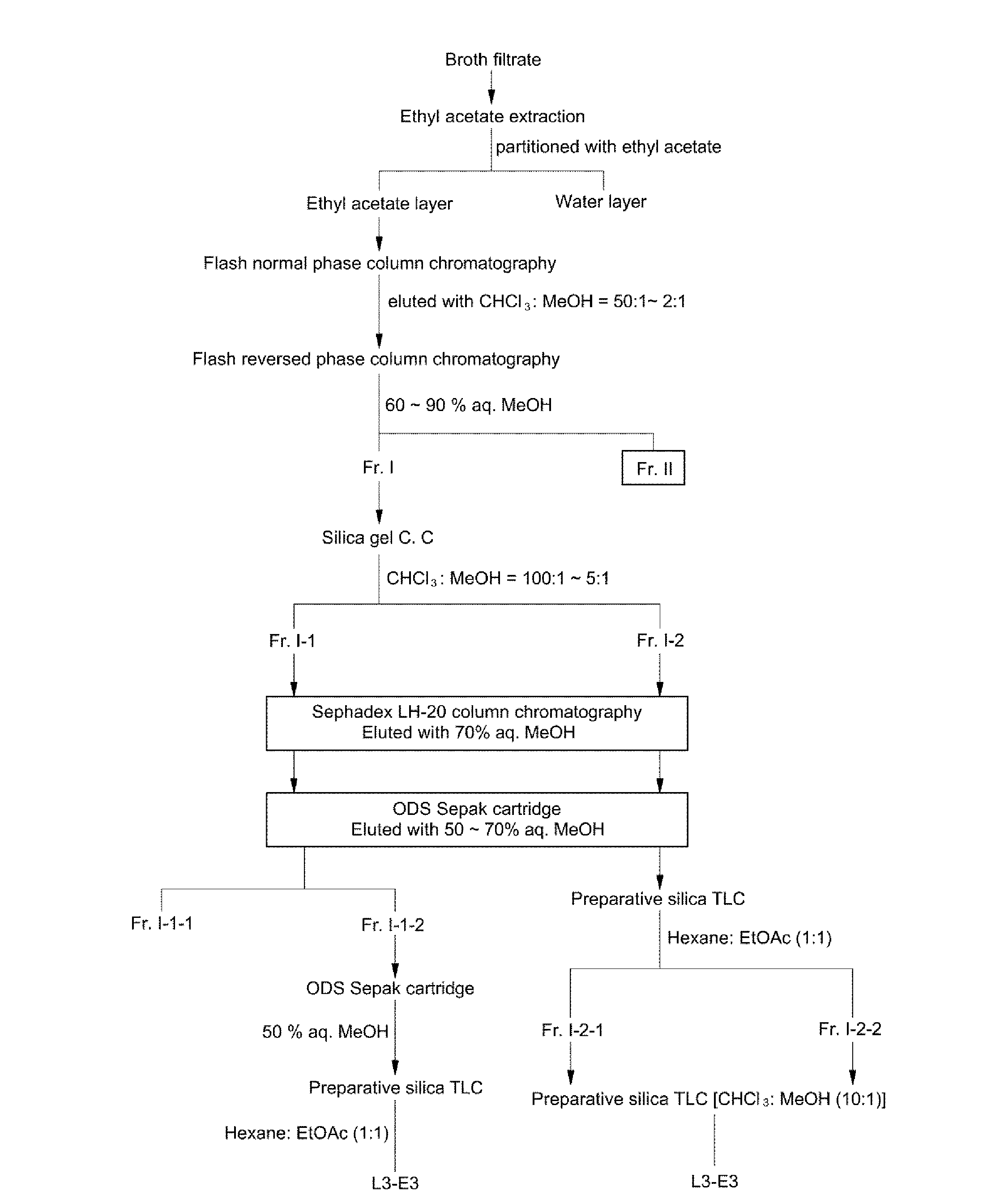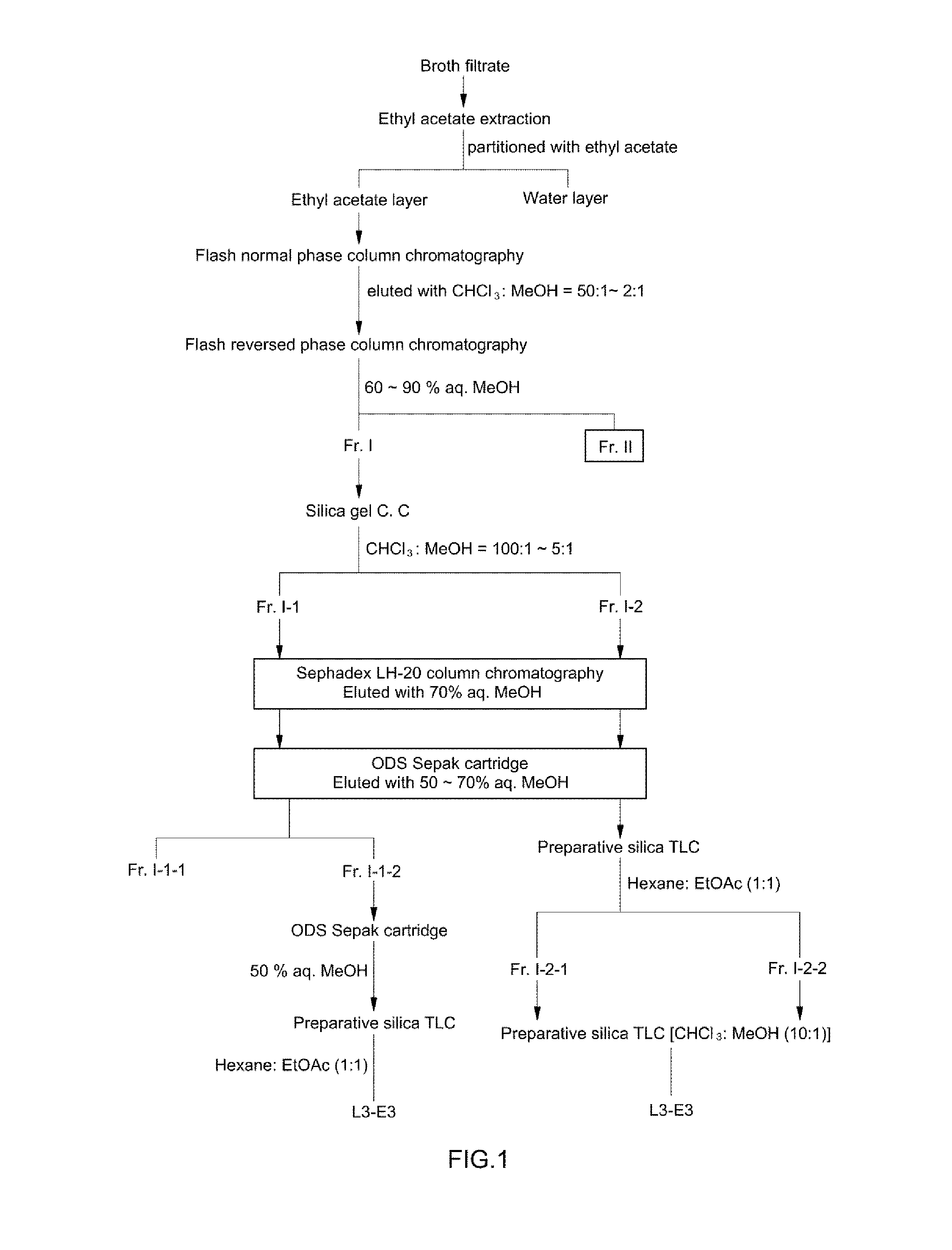Biosurfactant compounds produced by Aureobasidium pullulans
a technology of biosurfactants and aureobasidium pullulans, which is applied in the direction of organic chemistry, synthetic polymer active ingredients, fungi-based processes, etc., can solve the problems of serious environmental pollution, chemical surfactants can be problematic, and threaten aquatic ecosystems, and achieve excellent surfactant activity and effective use
- Summary
- Abstract
- Description
- Claims
- Application Information
AI Technical Summary
Benefits of technology
Problems solved by technology
Method used
Image
Examples
example 1
Isolation and Purification of Active Fractions Fr. I-1-1 and Fr. I-1-2 from Aureobasidium pullulans L-3-GPY Strain
[0051]The present invention is characterized by using Aureobasidium pullulans L-3-GPY which has been deposited under Accession No. KCCM11200P at Korean Culture Center of Microorganisms (KCCM) on Jul. 5, 2011.
[0052]A freeze-dried culture supernatant of Aureobasidium pullulans L-3-GPY (about 100 kg) was dissolved in water, followed by ethyl acetate (200 L) extraction and liquid-liquid partitioning twice. After an ethyl acetate phase was concentrated under reduced pressure, it was subjected to flash normal phase (silica gel) column chromatography using an eluting solvent of chloroform:methanol (50:1→2:1, v / v) (FIG. 1).
[0053]A chloroform:methanol (50:1, v / v) fraction showing strong desired activities was concentrated, followed by flash reversed-phase (ODS, C18) column chromatography using an eluting solvent of 60%→90% aqueous methanol. As a result, two active fractions Fr. I...
example 2
Isolation and Purification of Compound L3-E3 from Fr. I-1-2 Fraction
[0055]The fraction Fr. I-1-2 was subjected to reversed-phase (ODS, C18) Sepak cartridge chromatography using 50% aqueous methanol and preparative silica gel TLC (hexane:ethyl acetate=1:1, v / v), to thereby purify the compound L3-E3.
[0056]Among them, the compound L3-E3 showed almost the same Rf values on a silica gel TLC plate, which was carried out using chloroform:methanol (10:1, v / v) as the solvent. However, compound L3-E3 showed significantly different Rf values on a silica gel TLC plate, which was carried out using hexane:ethyl acetate (1:1, v / v) as the solvent.
example 3
Isolation and Purification of Active Fraction Fr. II from Aureobasidium pullulans L-3-GPY
[0057]As disclosed in Example 1, a freeze-dried culture supernatant of Aureobasidium pullulans L-3-GPY (about 100 kg) was dissolved in water, followed by ethyl acetate (200 L) extraction and liquid-liquid partitioning twice. After an ethyl acetate phase was concentrated under reduced pressure, it was subjected to flash normal phase (silica gel) column chromatography using an eluting solvent of chloroform:methanol (50:1→2:1, v / v) (FIG. 1).
[0058]A chloroform:methanol (50:1, v / v) fraction showing strong desired activities was concentrated, followed by flash reversed-phase (ODS, C18) column chromatography using an eluting solvent of 60%→90% aqueous methanol. As a result, two active fractions Fr. I (fraction eluted with 80% aqueous methanol) and Fr. II (fraction eluted with 90% aqueous methanol) were collected.
[0059]First, the fraction Fr. I was concentrated under reduced pressure and subject to sili...
PUM
| Property | Measurement | Unit |
|---|---|---|
| surface tension | aaaaa | aaaaa |
| surface tension | aaaaa | aaaaa |
| surface tension | aaaaa | aaaaa |
Abstract
Description
Claims
Application Information
 Login to View More
Login to View More - R&D
- Intellectual Property
- Life Sciences
- Materials
- Tech Scout
- Unparalleled Data Quality
- Higher Quality Content
- 60% Fewer Hallucinations
Browse by: Latest US Patents, China's latest patents, Technical Efficacy Thesaurus, Application Domain, Technology Topic, Popular Technical Reports.
© 2025 PatSnap. All rights reserved.Legal|Privacy policy|Modern Slavery Act Transparency Statement|Sitemap|About US| Contact US: help@patsnap.com



